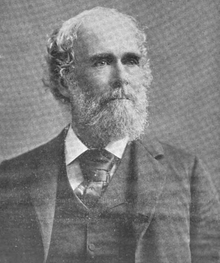Martin Luther Holbrook
Martin Luther Holbrook (February 3, 1831 - August 12, 1902) was an American physician and vegetarian activist associated with the natural hygiene and physical culture movements.
Martin Luther Holbrook | |
|---|---|
 | |
| Born | February 3, 1831 |
| Died | August 12, 1902 (aged 71) |
| Occupation | Physician, writer |
Biography
Holbrook was born in Mantua Township, Portage County, Ohio.[1] Holbrook graduated from Ohio Agricultural College and edited the Ohio Farmer (1859-1861).[2] During 1861-1863, Holbrook worked with Dio Lewis in Boston to promote physical culture and hygiene.[1] He graduated from Lewis's Normal School of Physical Culture.[2] He moved to New York City and obtained his medical degree from the Hygeio-Therapeutic College in 1864.[3]
Holbrook was coproprietor of the New Hygienic Institute at Laight Street in New York City, the property was previously Russell Trall's water-cure institution.[4][5] A Turkish bath was located at the institute.[1][4][6] He was a founder of Miller, Wood and Holbrook firm and Miller, Wood & Co publishers of medical books. He later published under his own name, M. L. Holbrook and was an important publisher of medical and hygienic literature up until the 1890s.[2][7] The printing press was located at Laight Street in New York City.[7] It shared the same address as Russell Trall's New York Hygeio-Therapeutic College.[7]
Holbrook was a vegetarian and promoted abstinence from alcohol, coffee, meat, tea, and tobacco.[2][8] He translated the German raw food book Fruit and Bread by Gustav Schlickeysen. The book promoted a fruitarian diet of uncooked fruits, grains and nuts.[8]
Holbrook was an advocate of chastity. His 1894 book on the subject recommended a physical culture regimen to increase the body's strength and diminish "morbid craving for unnatural and unreasonable indulgence of the passional nature."[2] He was a prominent eugenicist and authored the 1897 book Stirpiculture, later re-printed as Homo-Culture.
The Herald of Health
From 1866, Holbrook was a long-term editor for Russell Trall's The Herald of Health (it became the Journal of Hygiene in 1893).[2][7] He edited the journal until 1898.[1] It was a very popular journal.[9]
In 1898, the journal was renamed Omega and was edited by Holbrook and Charles Alfred Tyrrell.[10] It merged with Physical Culture.[5]
Selected publications
Holbrook's publications can be found in the New York Public Library.[11]
- Parturition without Pain: A Code of Directions for Escaping the Primal Curse (1874)
- Hygiene of the Brain and Nerves and the Cure of Nervousness (1878)
- How to Strengthen the Memory (1886)
- Dr. Holbrook's American Cookery (1888)
- Eating for Strength (1888)
- Physical, Intellectual, and Moral Advantages of Chastity (1894)
- Stirpiculture: Or, the Improvement of Offspring Through Wiser Generation (1897)[12]
- Homo-Culture: Or, the Improvement of Offspring Through Wiser Generation (1899)
References
- Anonymous. (1902). Dr. Martin Luther Holbrook. The Publisher's Weekly 62 (1594): 249-250.
- Hoolihan, Christopher. (2001). An Annotated Catalogue of the Edward C. Atwater Collection of American Popular Medicine and Health Reform, Volume 1. University of Rochester Press. p. 460-465. ISBN 1-58046-098-4
- Anonymous. (1902). Obituary Notes. Medical Record 62 (8): 301.
- Weiss, Harry Bischoff; Kemble, Howard R. (1967). The Great American Water-Cure Craze: A History of Hydropathy in the United States. The Past Times Press. p. 83
- Whorton, James C. (2016 edition). Crusaders for Fitness: The History of American Health Reformers. Princeton University Press. pp. 139-140. ISBN 978-0691641898
- "The first Turkish baths in the USA: New York: Manhattan: Laight Street". Retrieved 8 July 2019.
- Brodie, Janet Farrell. (1994). Contraception and Abortion in Nineteenth-century America. Cornell University Press. p. 338. ISBN 0-8014-8433-2
- Iacobbo, Karen; Iacobbo, Michael. (2004). Vegetarian America: A History. Praeger Publishing. p. 119. ISBN 978-0275975197
- Anonymous. (1876). The Herald of Health. Am J Dent Sci 9 (9): 432.
- Todd, Jan; Roark, Joe; Todd, Terry. (1991). A Briefly Annotated bibliography of English Language Serial Publications in the Field of Physical Culture. Iron Game History 1 (4-5): 25-40.
- Lord, Andrew Roberts. (1942). Holbrook and Allied Families. New York: Thesis Publishing Company. p. 58
- Newcomb McGee, Anita. (1898). Reviewed Work: Stirpiculture; Or the Improvement of Offspring Through Wiser Generation by M. L. Holbrook. American Anthropologist 11 (1): 24.